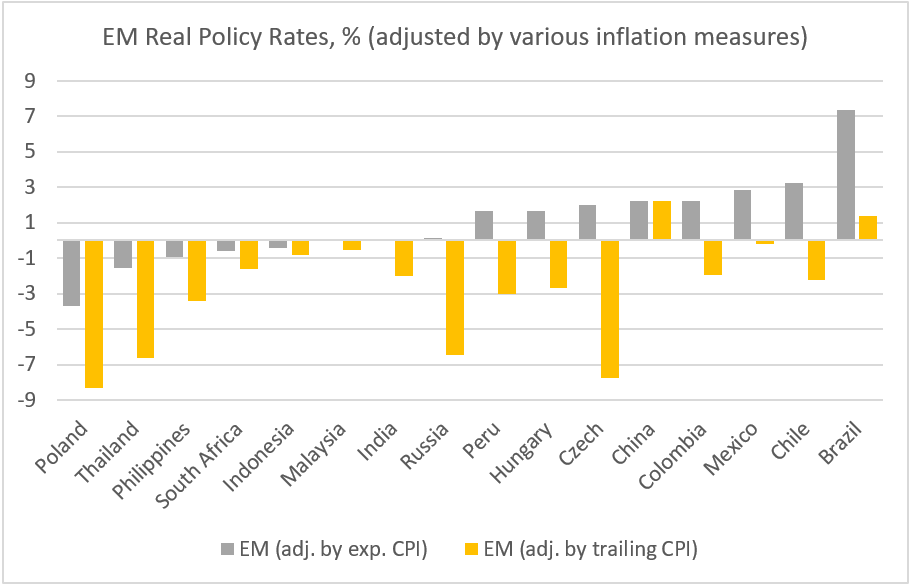By Natalia Gurushina
Chief Economist, Emerging Markets Fixed Income
EM continues to deliver gutsy policy moves – but not all of them are positive (like Hungary’s oversized rate hike). Poland’s below-consensus policy rate increase puts it further behind the curve.
EM Rate Hikes Frontloading
The morning headline about the Philippine central bank (BSP) being ready for a 50bps rate hike by August looked impressive. We even had a nice idea for the blog title – something along the lines of “central banks in emerging markets (EM) Asia are in the rate hikes frontloading mood”. But then we’ve got another round of policy rate “fireworks” in Hungary – a super-sized and surprising 200bps increase in the 1-week deposit rate, which came on the heels of an equally striking 185bps increase in the base rate about a week ago. It’s hard to believe that the Hungarian National Bank (NBH) is in a close regional proximity with the ECB… But we digressed. The NBH’s motives were two-fold – persistent inflation pressures and the currency’s weakness (the latter is a major reason why Hungary’s local bonds showed by far the worst year-to-date total return among all GBI-EM constituents). The hikes pushed Hungary’s real policy rate adjusted by expected inflation (ex-ante) well into positive territory (see chart below), reducing pressure to frontload more tightening going forward.
EMs Ahead or Behind the Curve?
Mexico’s ex-ante real policy rate also looks quite healthy after the latest 75bps rate hike. So, would the central bank need to do +75bps more after today’s inflation prints? Annual headline inflation is “flirting” with 8%, and core inflation climbed higher in June (albeit a bit less than expected). The next batch of bi-weekly CPI prints on July 22 would be key to watch. Unlike Hungary or Mexico, Poland’s ex-ante real policy rate is quite depressing (see chart below). So, today’s below-consensus 50bps rate hike also falls into the “gutsy” category but with a negative sign.
China Infrastructure Bet to Support Growth
Central banks are not the only entities in EM that frontload policy responses, governments can do it as well – China’s reported USD200B special bond sale is a good example. The bond sales will be coming from the 2023 quota, and they are sizable (in the same ballpark as an average monthly increase in the new yuan loans in the past few years) – this is a gutsy part. However, the move is supply-side/infrastructure oriented – while demand side remains an “orphan”, leading to concerns about the unbalanced recovery. A related “global” question here is whether Europe’s growth can piggyback on China’s rebound via trade channels – as would normally be expected. Or would Europe’s gas supply issues weaken this link in 2022? Stay tuned!
Chart at a Glance: Real Policy Rates in EM – Some Look Better, Some Lag Behind

Source: VanEck Research; Bloomberg LP
Originally published by VanEck on 7 July 2022.
For more news, information, and strategy, visit the Beyond Basic Beta Channel.
PMI – Purchasing Managers’ Index: economic indicators derived from monthly surveys of private sector companies. A reading above 50 indicates expansion, and a reading below 50 indicates contraction; ISM – Institute for Supply Management PMI: ISM releases an index based on more than 400 purchasing and supply managers surveys; both in the manufacturing and non-manufacturing industries; CPI – Consumer Price Index: an index of the variation in prices paid by typical consumers for retail goods and other items; PPI – Producer Price Index: a family of indexes that measures the average change in selling prices received by domestic producers of goods and services over time; PCE inflation – Personal Consumption Expenditures Price Index: one measure of U.S. inflation, tracking the change in prices of goods and services purchased by consumers throughout the economy; MSCI – Morgan Stanley Capital International: an American provider of equity, fixed income, hedge fund stock market indexes, and equity portfolio analysis tools; VIX – CBOE Volatility Index: an index created by the Chicago Board Options Exchange (CBOE), which shows the market’s expectation of 30-day volatility. It is constructed using the implied volatilities on S&P 500 index options.; GBI-EM – JP Morgan’s Government Bond Index – Emerging Markets: comprehensive emerging market debt benchmarks that track local currency bonds issued by Emerging market governments; EMBI – JP Morgan’s Emerging Market Bond Index: JP Morgan’s index of dollar-denominated sovereign bonds issued by a selection of emerging market countries; EMBIG – JP Morgan’s Emerging Market Bond Index Global: tracks total returns for traded external debt instruments in emerging markets.
The information presented does not involve the rendering of personalized investment, financial, legal, or tax advice. This is not an offer to buy or sell, or a solicitation of any offer to buy or sell any of the securities mentioned herein. Certain statements contained herein may constitute projections, forecasts and other forward looking statements, which do not reflect actual results. Certain information may be provided by third-party sources and, although believed to be reliable, it has not been independently verified and its accuracy or completeness cannot be guaranteed. Any opinions, projections, forecasts, and forward-looking statements presented herein are valid as the date of this communication and are subject to change. The information herein represents the opinion of the author(s), but not necessarily those of VanEck.
Investing in international markets carries risks such as currency fluctuation, regulatory risks, economic and political instability. Emerging markets involve heightened risks related to the same factors as well as increased volatility, lower trading volume, and less liquidity. Emerging markets can have greater custodial and operational risks, and less developed legal and accounting systems than developed markets.
All investing is subject to risk, including the possible loss of the money you invest. As with any investment strategy, there is no guarantee that investment objectives will be met and investors may lose money. Diversification does not ensure a profit or protect against a loss in a declining market. Past performance is no guarantee of future performance.







